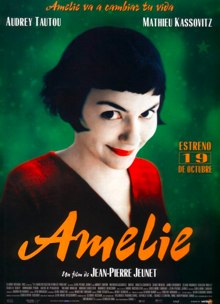 |
|
I saw and enjoyed Amelie dispite the fact that Audrey Tautou’s eyes in this movie poster really creeped me out. |
I don’t enjoy watching foreign films with subtitles. I’m almost always glad that I did, but it’s work for me — and I usually go to the movies to relax. There is also, I’m sure, some discomfort associated with my not being a successful foreign language student when I was in school, doing only slightly better in Latin than in French and Spanish classes. ..and references to my fairly severe hearing difficulties probably provide more consolation to me than a real excuse for my academic failures. Never really had to listen to Latin.
But I remember a conversation at one of the foreign language teachers conferences I’ve spoken at about how immigrants are developing their English language skills by switching on the closed caption feature of their TVs — and that’s the memory that surfaced when I learned about AnySubs. It’s a collaborative archive of files that provide subtitles for movies, operating along side the movie file. Here’s how it works.
- You go to AnySubs, and type the title, or a string from the title of the movie you wish to read along with. I happened to have an MP4 of Mary Poppins in an external hard drive. With the proper number of Ps, I find an entry for the 1964 movie and learn that it got a 7.6 user rating from IMDb.
- Clicking the entry, I learn that there are two English subtitle files and one in Finish. One of the English files might be used by students with hearing deficiencies, but pretending I’m teaching Finish to my high schoolers, I click that entry and then click Download.
- The subtitle downloads are compressed. One I ran across last night was zipped (.zip), but this one is compressed in Roshal ARchive, or RAR (.rar) format. Fortunately, Stuffit Expander handles it flawlessly. Although there are others, the subtitle decompressed files I’ve downloaded were in SubRip format (.srt).
- After that, the process is simple, though I had to do some research to learn it — as the AnySubs site seems to be fairly Windows-centric.
 The movie file (most formats seem to be workable) and the subtitles file must be in the same folder or directory, and they must have the same filename — except for the extension. Several movie players seem to support subtitles, but not QuickTime, at least from my experiments. So I re-acquired VLC, a cross-platform open source media player that handles a wide array of video and audio formats. Opening the movie file with VLC, the Finnish subtitles automatically appear, as I watch one of my children’s favorite childhood movies.
The movie file (most formats seem to be workable) and the subtitles file must be in the same folder or directory, and they must have the same filename — except for the extension. Several movie players seem to support subtitles, but not QuickTime, at least from my experiments. So I re-acquired VLC, a cross-platform open source media player that handles a wide array of video and audio formats. Opening the movie file with VLC, the Finnish subtitles automatically appear, as I watch one of my children’s favorite childhood movies.
Now I can imagine developing my skills in this language (after mastering the vowels) by watching familiar movies and TV shows and making myself read the captions — or finding a Finnish film and applying English subtitles. But I suspect that language teachers can come up with some creative ways to use this.
What do you think?

Powered by ScribeFire.


